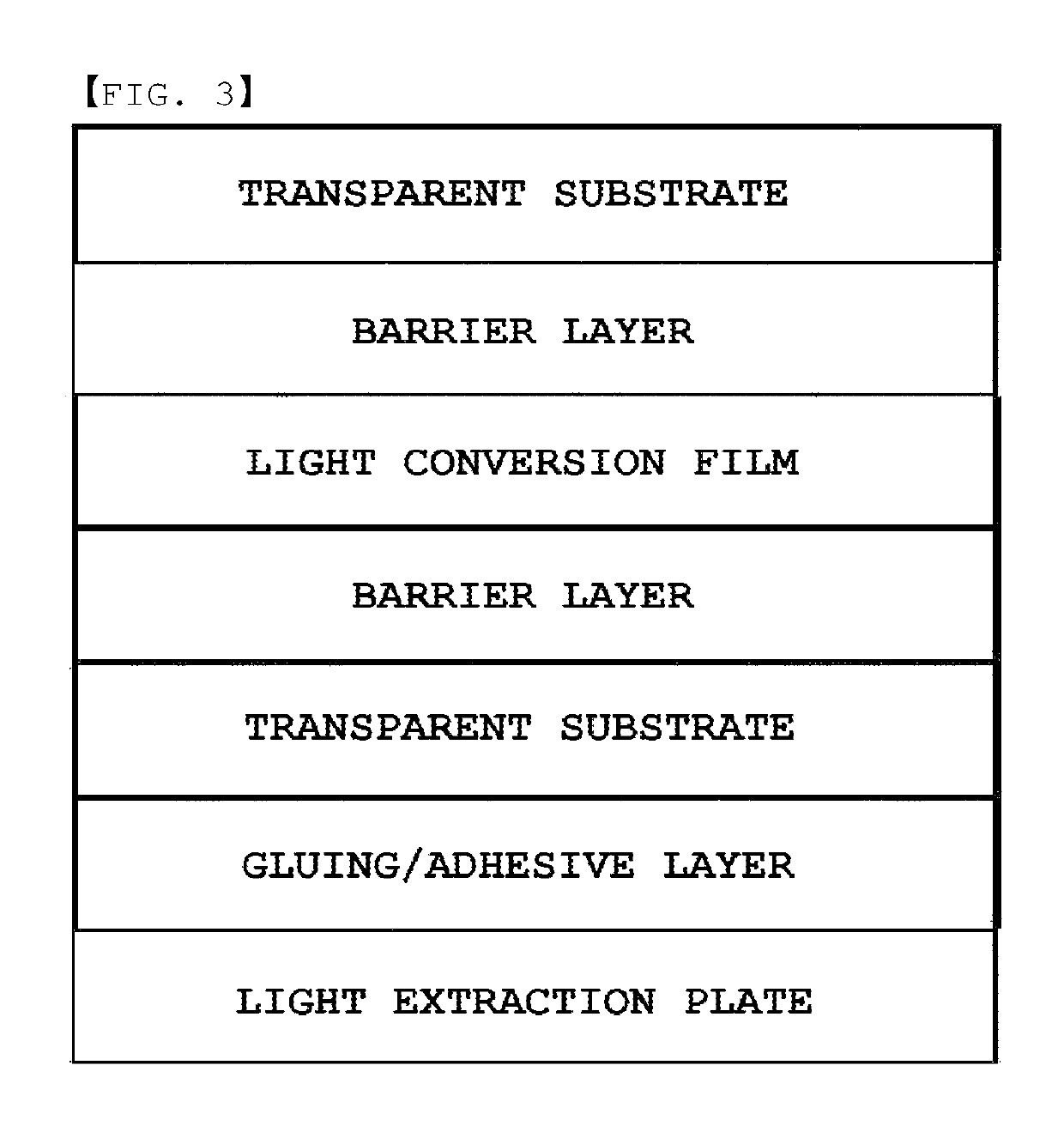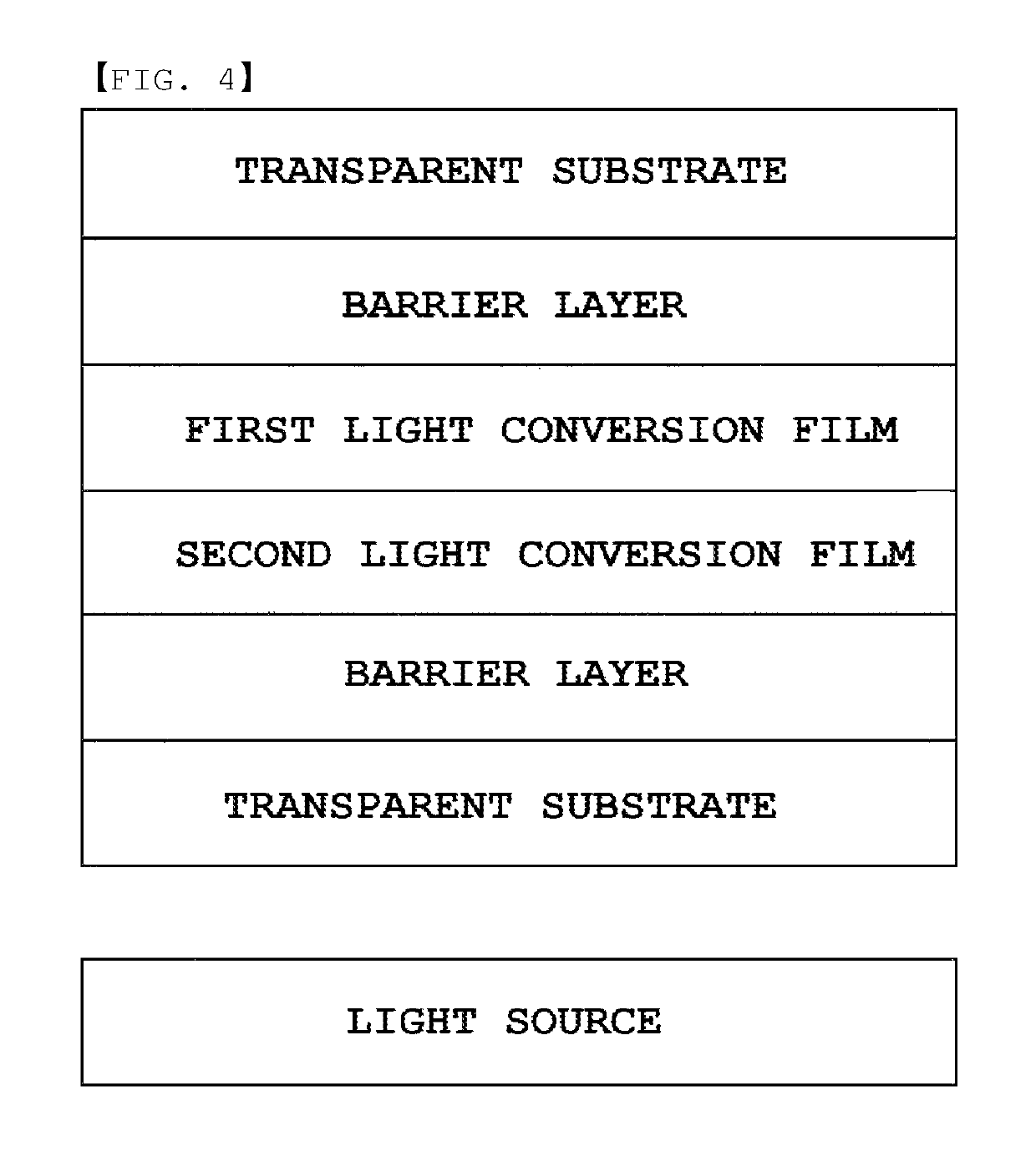Photoconversion film, and photoconversion element and display device comprising same
a light conversion film and light conversion technology, applied in the field of light conversion film and light conversion device, can solve the problems of low light emission efficiency, high price of fluorescent substance, limited development of fluorescent substance excited and emitting light in the near ultraviolet or blue region of 400 nm or higher, etc., to achieve the effect of enhancing light extraction efficiency and increasing light conversion efficiency of light conversion film
- Summary
- Abstract
- Description
- Claims
- Application Information
AI Technical Summary
Benefits of technology
Problems solved by technology
Method used
Image
Examples
example 1
[0023]In 20 g of water, 1 g of polyvinyl alcohol (PVA) having a weight average molecular weight (Mw) of 85,000 to 124,000 and a degree of saponification of 87% was completely dissolved at a temperature of 150° C., and to the cooled solution, 4 g of polyethyleneimine (PEI) having a weight average molecular weight (Mw) of 10,000 and epichlorohydrin in 15% with respect to the PEI weight were added and dissolved at room temperature. To the composition, pyranine, a green fluorescent dye, was added in 0.3% with respect to the polymer weight (sum of PVA and PEI weights) of the composition to prepare a composition for forming a film. The composition for forming a film prepared using the above-mentioned method was coated on a barrier layer-formed barrier film using a wire bar, and thermosetting was induced while hot-air drying the result for 5 minutes in a 100° C. drying oven, and then a separate barrier film was laminated on the film. Lastly, a light extraction film was laminated on one sur...
example 2
[0024]To 20 g of water, 1 g of polyallylamine (PAA) having a weight average molecular weight (Mw) of 65,000, 4 g of polyethyleneimine (PEI) having a weight average molecular weight (Mw) of 10,000, and epichlorohydrin in 15% with respect to the PEI weight were added and dissolved at room temperature, and to the composition, pyranine, a green fluorescent dye, was added in 0.3% with respect to the polymer weight (sum of PAA and PEI weights) of the composition to prepare a composition for forming a film. The composition for forming a film prepared using the above-mentioned method was coated on a barrier layer-formed barrier film using a wire bar, and thermosetting was induced while hot-air drying the result for 5 minutes in a 100° C. drying oven, and then a separate barrier film was laminated on the film. Lastly, a light extraction film was laminated on one surface of the barrier film to complete a green light conversion device having a structure as in FIG. 6.
experimental example
[0029]In order to test adhesive strength of the light conversion film according to one embodiment of the present specification, the surface of the barrier film laminated on the light conversion film was cross-cut in a line form such as a checkboard spaced 1 mm apart using a knife in accordance with the ASTM standard, then a cellophane tape was attached thereon, and adherence when removing the tape was determined. The results are shown in the following Table 1. ◯ indicates being completely adhered, and X indicates space between the checkboard pattern being partially peeled-off or completely peeled-off.
[0030]
TABLE 1CategoryAdhesionExampleExample 1◯Example 2◯Comparative ExampleComparative Example 1XComparative Example 2X
[0031]As shown in Table 1, the light conversion film according to one embodiment of the present specification had the desired effect in the adhesive property compared to the comparative examples that did not include an ionic polymer.
[0032]Hereinafter, embodiments of the...
PUM
| Property | Measurement | Unit |
|---|---|---|
| FWHM | aaaaa | aaaaa |
| light emission wavelength | aaaaa | aaaaa |
| light emission wavelength | aaaaa | aaaaa |
Abstract
Description
Claims
Application Information
 Login to View More
Login to View More - R&D
- Intellectual Property
- Life Sciences
- Materials
- Tech Scout
- Unparalleled Data Quality
- Higher Quality Content
- 60% Fewer Hallucinations
Browse by: Latest US Patents, China's latest patents, Technical Efficacy Thesaurus, Application Domain, Technology Topic, Popular Technical Reports.
© 2025 PatSnap. All rights reserved.Legal|Privacy policy|Modern Slavery Act Transparency Statement|Sitemap|About US| Contact US: help@patsnap.com



